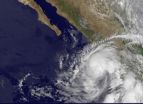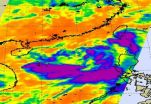(Press-News.org) How does the power output from solar panels fluctuate when the clouds roll in? And can researchers predict these fluctuations? UC San Diego Professor Jan Kleissl and Matthew Lave, a Ph.D. student in the Department of Mechanical and Aerospace Engineering at the Jacobs School, have found the answer to these questions. They also have developed a software program that allows power grid managers to easily predict fluctuations in the solar grid caused by changes in the cloud cover. The program uses a solar variability law Lave discovered.
The finding comes at a time when the Obama administration is pushing for the creation of a smart power grid throughout the nation. The improved grid would allow for better use of renewable power sources, including wind and solar.
Also, more utilities have been increasing the amount of renewable energy sources they use to power homes and businesses. For example, Southern California Edison reported this month that it is adding more large-scale solar power plants to its grid and retooling its distribution system to accommodate the power fluctuations that will follow.
Kleissl and Lave's finding could have a dramatic impact on the amount of solar power allowed to feed into the grid. Right now, because of concerns over variability in power output, the amount of solar power flowing in the grid at residential peak demand times—your typical sunny weekend afternoon in Southern California, say—is limited to 15 percent before utilities are required to perform additional studies. As operators are able to better predict a photovoltaic system's variability, they will be able to increase this limit. In California, a law signed by Gov. Jerry Brown in April 2011 requires all electricity retailers in the state, including publicly owned utilities, to generate 33 percent of their power sales from renewable energy sources by 2020.
Incidentally, Kleissl and Lave's research shows that the amount of solar variability can also be reduced by installing smaller solar panel arrays in multiple locations rather than building bigger arrays in just one spot, since a cloud covering one panel is less likely to cover the other panels, Lave said.
"The distance between arrays is key," he said.
The variability in the output of photovoltaic power systems has long been a source of great concern for utility operators worldwide. But Kleissl and Lave found that variability for large photovoltaic systems is much smaller than previously thought. It also can be modeled accurately, and easily, based on measurements from just a single weather station. Kleissl presented the paper, titled 'Modeling Solar Variability Effects on Power Plants,' this week at the National Renewable Energy Laboratory in Golden, Colo.
His findings are based on analysis of one year's worth of data from the UC San Diego solar grid—the most monitored grid in the nation, with 16 weather stations and 5,900 solar panels totaling 1.2 megawatts in output. Lave looked at variations in the amount of solar radiation the weather stations were receiving for intervals as short as a second. The amount of radiation correlates with the amount of power the panels produce.
Based on these observations, he found that when the distance between weather stations is divided by the time frame for the change in power output, a solar variability law ensues. This operation was inspired by a presentation by Clean Power Research, a Napa-based company, at the Department of Energy – California Public Utility Commission High Penetration Solar forum hosted by UC San Diego in March 2011. "For any pair of stations at any time horizon, this variability law is applicable" says Lave. In other words, the law can be applied to any configuration of photovoltaic systems on an electric grid to quantify the system's variability for any given time frame.
But Lave didn't stop there. He developed an easy-to-use interface in MATLAB that allows grid planners and operators to simulate the variability of photovoltaic systems. Data can be input as a text file, but the interface also allows users to simply draw a polygon around each system on a satellite Google Map. Based on solar radiation measurements at a single sensor on a given day, the model calculates the variability in total output across all systems.
"It is as easy as painting by numbers," said Kleissl. "In Google Maps, photovoltaics show up as dark rectangles on rooftops. Draw some polygons around them, push the button, and out comes the total variability."
Kleissl said he anticipates this tool will be useful to figure out whether problems in voltage fluctuation may occur in power feeder systems with a large amount of photovoltaic arrays. At this point, the solar installations on almost all feeders are still far below the capacity that would cause any major issues. But as the United States moves to affordable solar systems producing energy at lower costs through the Department of Energy's SunShot initiative and continued robust growth in installations, this will change. That's when the tool developed by Lave and Kleissl could become key.
The model development was sponsored by DOE's High PV Penetration Program grant 10DE-EE002055. Further information is available at https://solarhighpen.energy.gov/project/university_of_california_san_diego and http://solar.ucsd.edu
While the tool is being prepared for final public release, the authors would be happy to consider requests by third parties that can provide PV system location and size data to run the tool.
INFORMATION: END
It will soon be happening again! On May 18th Chef Point Cafe rolled back the price of gasoline from 6:30-7:30 a.m. to 99 cents per gallon to show appreciation to their loyal horde of customers and to also kick off their "99" deals in celebration of their restaurant expansion. And on July 4th their next "99" deal will take place. The big question is: what will the deal be this time?
This wildly popular and iconic Ft. Worth fine dining establishment is in the process of "remembering when" things were simpler in America; when 99 cents could ...
Researchers at the Intermountain Medical Center Heart Institute in Salt Lake City have identified the first genetic mutation ever associated with a mysterious and potentially devastating form of heart disease that affects women in the final weeks of pregnancy or the first few months after delivery.
The disease, peripartum cardiomyopathy (PPCM), weakens a woman's heart so that it no longer pumps blood efficiently. The disease is relatively rare, affecting about one in 3,000 to 4,000 previously healthy American women. Most PPCM patients are treated with medicine, but about ...
You've just been told you're going on a trip. The only problem is, you don't know where you're going, how you'll be traveling, or what you'll do when you get there.
Sound like a wild ride? It's the one our planet is on right now. As land use, human population, consumption and atmospheric greenhouse gas concentrations change at an unprecedented pace with complex and unpredictable interactions, it's anybody's guess where we'll end up or what we can do to ensure the most favorable outcome.
Recognizing that "guess" is not good enough when talking about the viability of ...
INDIANA DUNES NATIONAL LAKESHORE, Ind. —Native bees – often small, stingless, solitary and unnoticed in the flashier world of stinging honeybees – are quite discriminating about where they live, according to U.S. Geological Survey research.
The study found that, overall, composition of a plant community is a weak predictor of the composition of a bee community, which may seem counterintuitive at first, said USGS scientist and study lead Ralph Grundel. This may be because specialized plant-bee interactions, in which a given bee species only pollinates one plant species ...
BLACKVILLE, S.C. — Scientists from Clemson University and the USDA Agricultural Research Service have developed a new variety of not-so-sweet potato, called Liberty.
Known as a boniato, or tropical sweet potato, Liberty has a dark red skin and light yellow, dry flesh with a bland flavor. Boniato potatoes originated in the tropical Americas and are grown in south Florida in the United States. They can be served fried, mashed or in soup.
"We developed Liberty because other boniato varieties are susceptible to damage by nematodes (microscopic parasitic worms)," said John ...
An international team of scientists led by researchers at the University of California, San Diego School of Medicine have used induced pluripotent stem cells (iPSCs) derived from patients with amyotrophic lateral sclerosis (ALS) to reveal for the first time how reduced levels of a specific protein may play a central role in causing at least one inherited form of the disease.
The work, published in the June 2011 online issue of the journal Human Molecular Genetics, could help scientists overcome a major hurdle in the study and treatment of ALS, an incurable neuromuscular ...
AMARILLO – One potato field west of Bushland hosts three separate studies, all aimed at helping growers nationwide, even internationally, understand the habits and controls of the potato psyllid.
The potato psyllid is the insect that transmits a bacterium that causes the relatively new disease in potatoes known as zebra chip, according to Dr. Charlie Rush, Texas AgriLife Research plant pathologist.
The team of AgriLife Research scientists and a Texas AgriLife Extension Service specialist is working on potato psyllid control and epidemiology of disease transmission under ...
Hurricane Beatriz is skirting the southwestern Mexican coast today, June 21 and bringing heavy rains and high surf to coastal areas, including Mexico's biggest port. NASA satellite imagery showed that Beatriz seemed to develop an eye that opened on microwave imagery and closed on visible imagery, appearing to give satellites a "wink."
Last night (June 20, 2011) by 8 p.m. EDT, heavy rains were spreading over the southwestern Mexican coast. At that time, Beatriz was still a tropical storm. By 11 p.m. EDT Beatriz had strengthened into a hurricane. At 5 a.m. EDT today, June ...
Tropical Depression 06W is still slowing, making its way through the South China Sea today and has weakened overnight. NASA infrared satellite imagery showed a much more disorganized storm with scattered convection, which accounts for its weakened status from tropical storm to tropical depression.
On June 21 at 1500 UTC (11 a.m. EDT) the newly weakened Tropical Depression 06W was located about 480 nautical miles east-southeast of Hanoi, Vietnam near 18.8 North and 113.8 East. Depression 06W's maximum sustained winds had decreased to 25 knots (28 mph/46 kmh). It was moving ...
Leading online casino CastleCasino.com has today furthered their live dealer offering with a new Spanish speaking version of their renowned live roulette game, broadcasted by real croupiers totally in Spanish.
The new Spanish version of the live roulette game is shown live during 19.30PM and 4.00AM GMT and will feature in addition to the current English speaking version of the game. As well as the croupiers interacting with players in the Spanish language, the new live roulette version game interface will also be designed in Spanish, making it the easier for Spanish ...



